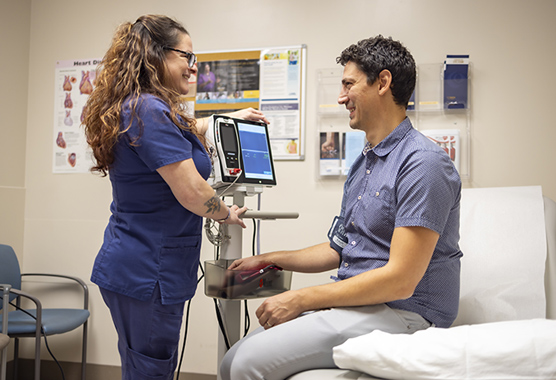Coronary Artery Disease (CAD)
Our team of specialists treats the number one cause of heart disease with skilled expertise and advanced techniques.
Medically reviewed by Surabhi Atreja, M.D. on July 14, 2025.

Understanding Coronary Artery Disease
Coronary artery disease (CAD) occurs when fatty deposits called plaque collect in the arteries that supply blood to the heart. This buildup narrows or blocks blood vessels, making it harder for your heart to function.
CAD is also known as ischemic heart disease because the heart can’t get enough blood, which carries oxygen to your organs. Left untreated, CAD can cause complications such as a heart attack, arrhythmia (irregular heartbeat), or heart failure.
If you receive a CAD diagnosis, our expert team works together with you to develop a personalized treatment plan. We use advanced skills and the latest techniques to address your specific needs and get your heart beating as it should.
CAD Symptoms
CAD doesn’t always cause symptoms. You may experience chest discomfort or pain (angina) as the first sign that something is wrong. Or your first indication of serious heart trouble could be a heart attack.
Without treatment, CAD can lead to other heart issues, such as arrhythmia or heart failure. Early detection is important for effective treatment.
Common Symptoms
While chest pain is the most common symptom of CAD, the sensation can vary from person to person. You may feel:
- Burning or aching
- Heaviness
- Pressure
- Sharp pain
- Squeezing
- Tightness
Emergency Symptoms
Call 911 immediately if you experience chest pain or heart attack symptoms, such as:
- Arm or shoulder discomfort
- Chest pain
- Cold sweats
- Indigestion or stomachache (especially in women)
- Nausea or vomiting
- Shortness of breath
Causes of Coronary Heart Disease
Coronary artery disease (CAD) occurs when plaque buildup narrows or blocks the blood vessels (arteries) that carry blood to your heart. As atherosclerosis – or buildup of plaque – progresses, reducing the blood flow to your heart. CAD forces your heart to work harder to pump blood to the rest of your body.
You may be at risk for developing atherosclerosis and CAD due to factors you can't control, such as family history. But you can reduce your risk for plaque buildup and CAD with lifestyle habits that help boost your health and keep your heart strong.
Risk Factors for CAD
You may be more likely to develop coronary artery disease if you have biological family members with CAD. Other risk factors include:
- Age: People over 65 years old have a higher risk of CAD.
- Biological sex: Men are more at risk for obstructive CAD, while women are at higher risk for non-obstructive disease.
It's important to maintain a healthy diet and lifestyle habits to reduce your risk of developing heart disease. You may be more likely to develop CAD if you:
- Don’t exercise regularly
- Eat a diet that lacks proper nutrition and includes processed foods
- Experience high levels of stress or poor sleep
- Have obesity, diabetes, high blood pressure, high cholesterol, or other health issues
- Use tobacco products
Talk to your health care provider if you are concerned about developing coronary heart disease. Together, you can come up with a customized plan to help maintain your heart health as you age.
Coronary Artery Disease Diagnosis and Testing
Your provider will ask about your medical history and symptoms and do a thorough physical exam to diagnose coronary artery disease. Your doctor may recommend a range of tests to confirm a CAD diagnosis or rule out other conditions.
You may undergo several common tests to check your heart, such as:
- Cardiac catheterization, which allows your doctor to view inside your heart and blood vessels
- Echocardiogram, which examines your heart’s structure and blood flow using ultrasound technology
- Electrocardiogram (EKG) which measures the electrical activity of your heart
- Imaging tests such as X-ray, CT scan, or MRI, which take detailed pictures of your heart, lungs, and blood vessels
- Stress test, which checks how your heart responds to exercise
Treatments for Coronary Artery Disease
Your specific treatment depends on your overall health, symptoms, and the severity of your artery blockage. Sometimes, lifestyle changes or medications can control your blood pressure and bring your weight and cholesterol into a healthy range. In other cases, you may need surgery to restore blood flow and heart function.
Medications
Your doctor may prescribe certain medications to treat chest pain, help control blood pressure, and lower cholesterol.
Lifestyle Changes
You and your doctor can discuss important lifestyle changes that you can make to reduce your risk for CAD and future heart problems. These lifestyle changes may include:
- Maintaining a healthy weight
- Lowering your blood pressure and cholesterol
- Eating a healthy diet
- Exercising regularly
Surgery
If the blockage in an artery is severe, you may need a procedure or surgery to help your heart work better. Your doctor may recommend:
- Stents: Cardiologists place stents (small tubes) inside the artery to support and open the artery. These can be placed during a non-surgical procedure called a percutaneous coronary intervention (PCI).
- Coronary artery bypass graft (CABG) surgery: CABG surgery is a procedure that helps restore blood flow. You may need this type of surgery if the blockage is in a main artery or if the blockage involves multiple arteries.
Cardiac Rehab
Cardiac rehab helps you strengthen your heart in a closely monitored environment. Our physical therapists create an exercise plan that is safe and effective, helping you focus on your recovery.
Preventing Heart Disease
The best prevention for atherosclerosis and coronary artery disease is a healthy body. To keep yourself as healthy as possible, try to:
Eat a whole-food diet
Limit sugar, alcohol, processed food, and fast food. Focus instead on eating lots of vegetables, fruits, lean protein (such as chicken and fish), whole grains, and healthy fats. Healthy fats include avocados, extra-virgin olive oil, nuts, seeds, and fatty fish.
Exercise regularly
Add physical activity to your daily life, engaging in moderate exercise at least three days a week. Talk to your doctor about safe exercises before starting if you have health or heart problems.
Maintain a healthy weight
Keeping a healthy weight helps your body and organs work at their best. Aim for a body mass index (BMI) under 25.
Quit smoking
Smoking, vaping, and using smokeless tobacco products cause your blood vessels to harden, encouraging plaque to form. People exposed to secondhand smoke are also at an increased risk for CAD.
Reduce stress and prioritize sleep
Chronic stress and lack of sleep drive inflammation in the body, increasing the risk of heart disease. Actively work to lessen stress by spending time in nature, taking walks, journaling, or performing other activities that relax you. Aim for seven to eight hours of sleep every night.
How many people in the U.S. are affected by CAD?
20.1MAdults over age 20
Annual deaths
382K+People died in the US in 2020 from CAD
How common is CAD?
#1Most common type of heart disease in the US
Request an Appointment
As Sacramento's No. 1 hospital, you'll benefit from unique advantages in primary care and specialty care. This includes prevention, diagnosis and treatment options from experts in 150 specialties.
Referring Physicians
To refer a patient, submit an electronic referral form or call.
800-4-UCDAVIS
Patients
Call to make an appointment.

